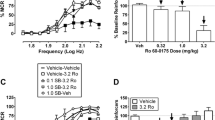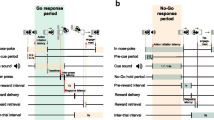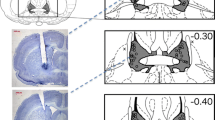Abstract
Rationale
Serotonin 2C (5-HT2C) receptors may play a role in regulating motivation and reward-related behaviours. To date, no studies have investigated the possible role of 5-HT2C receptors in ventral tegmental area (VTA) intracranial self-stimulation (ICSS).
Objectives
The current study investigated the hypotheses that 5-HT2C receptors play an inhibitory role in VTA ICSS, and that 5-HT2C receptors within the nucleus accumbens (NAc) shell may be involved.
Methods
Male Sprague–Dawley rats were implanted with a VTA electrode and bilateral NAc shell cannulae for the experiment involving microinjections, and trained to respond for electrical self-stimulation. The systemic effects of the selective 5-HT2C receptor agonist WAY 161503 (0–1.0 mg/kg), the 5-HT1A/1B/2C receptor agonist TFMPP (0.3 mg/kg) and the selective 5-HT2C receptor antagonist SB 242084 (1.0 mg/kg) were compared using rate-frequency threshold analysis. Intra-NAc shell microinjections of WAY 161503 (0–1.5 μg/side) were investigated and compared to amphetamine (1.0 μg/side).
Results
WAY 161503 (1.0 mg/kg) and TFMPP (0.3 mg/kg) significantly increased rate-frequency thresholds (M50 values) without altering maximal response rates (RMAX values). SB 242084 attenuated the effects of TFMPP; SB 242084 had no affect on M50 or RMAX values. Intra-NAc shell WAY 161503 had no effect on M50 or RMAX values; intra-NAc amphetamine decreased M50 values.
Conclusions
These results suggest that 5-HT2C receptors play an inhibitory role in regulating reward-related behaviour while 5-HT2C receptor activation in the NAc shell did not appear to influence VTA ICSS behaviour under the present experimental conditions.





Similar content being viewed by others
References
Alex KD, Pehek EA (2007) Pharmacologic mechanisms of serotonergic regulation of dopamine neurotransmission. Pharmacol Ther 113:296–320
Barnes NM, Sharp T (1999) A review of central 5-HT receptors and their function. Neuropharmacology 38:1083–1152
Bassareo V, De Luca MA, Di Chiara G (2007) Differential impact of Pavlovian drug conditioned stimuli on in vivo dopamine transmission in the rat accumbens shell and core and in the prefrontal cortex. Psychopharmacology (Berl) 191:689–703
Baumann MH, Clark RD, Budzynski AG, Partilla JS, Blough BE, Rothman RB (2005) N-substituted piperazines abused by humans mimic the molecular mechanism of 3,4-methylenedioxymethamphetamine (MDMA, or ‘Ecstasy’). Neuropsychopharmacology 30:550–560
Benloucif S, Keegan MJ, Galloway MP (1993) Serotonin-facilitated dopamine release in vivo: pharmacological characterization. J Pharmacol Exp Ther 265:373–377
Berg KA, Maayani S, Goldfarb J, Clarke WP (1998) Pleiotropic behavior of 5-HT2A and 5-HT2C receptor agonists. Ann N Y Acad Sci 861:104–110
Boothman L, Raley J, Denk F, Hirani E, Sharp T (2006) In vivo evidence that 5-HT(2C) receptors inhibit 5-HT neuronal activity via a GABAergic mechanism. Br J Pharmacol 149:861–869
Broadbent J, Greenshaw AJ (1985) Effects of quipazine and of tryptamine on self-stimulation of median raphe nucleus and of lateral hypothalamus in rats. Pharmacol Biochem Behav 23:943–947
Bubar MJ, Cunningham KA (2007) Distribution of serotonin 5-HT2C receptors in the ventral tegmental area. Neuroscience 146:286–297
Chanrion B, Mannoury la Cour C, Gavarini S, Seimandi M, Vincent L, Pujol JF, Bockaert J, Marin P, Millan MJ (2007) Inverse agonist and neutral antagonist actions of antidepressants at recombinant and native 5-HT2C receptors: differential modulation of cell surface expression and signal transduction. Mol Pharmacol 73:748–757
Clemett DA, Punhani T, Duxon MS, Blackburn TP, Fone KC (2000) Immunohistochemical localisation of the 5-HT2C receptor protein in the rat CNS. Neuropharmacology 39:123–132
Clifton PG, Lee MD, Somerville EM, Kennett GA, Dourish CT (2003) 5-HT1B receptor knockout mice show a compensatory reduction in 5-HT2C receptor function. Eur J Neurosci 17:185–190
Colle LM, Wise RA (1988) Effects of nucleus accumbens amphetamine on lateral hypothalamic brain stimulation reward. Brain Res 459:361–368
Cooper JC, Knutson B (2008) Valence and salience contribute to nucleus accumbens activation. Neuroimage 39:538–547
Cryan JF, Lucki I (2000) Antidepressant-like behavioral effects mediated by 5-Hydroxytryptamine(2C) receptors. J Pharmacol Exp Ther 295:1120–1126
Dalton GL, Lee MD, Kennett GA, Dourish CT, Clifton PG (2006) Serotonin 1B and 2C receptor interactions in the modulation of feeding behaviour in the mouse. Psychopharmacology (Berl) 185:45–57
De Deurwaerdere P, Spampinato U (1999) Role of serotonin(2A) and serotonin(2B/2C) receptor subtypes in the control of accumbal and striatal dopamine release elicited in vivo by dorsal raphe nucleus electrical stimulation. J Neurochem 73:1033–1042
Di Giovanni G, Di Matteo V, Di Mascio M, Esposito E (2000) Preferential modulation of mesolimbic vs. nigrostriatal dopaminergic function by serotonin(2C/2B) receptor agonists: a combined in vivo electrophysiological and microdialysis study. Synapse 35:53–61
Di Giovanni G, Di Matteo V, La Grutta V, Esposito E (2001) m-Chlorophenylpiperazine excites non-dopaminergic neurons in the rat substantia nigra and ventral tegmental area by activating serotonin-2C receptors. Neuroscience 103:111–116
Di Matteo V, Di Giovanni G, Di Mascio M, Esposito E (1999) SB 242084, a selective serotonin2C receptor antagonist, increases dopaminergic transmission in the mesolimbic system. Neuropharmacology 38:1195–1205
Dremencov E, Newman ME, Kinor N, Blatman-Jan G, Schindler CJ, Overstreet DH, Yadid G (2005) Hyperfunctionality of serotonin-2C receptor-mediated inhibition of accumbal dopamine release in an animal model of depression is reversed by antidepressant treatment. Neuropharmacology 48:34–42
Egashira N, Koushi E, Mishima K, Iwasaki K, Oishi R, Fujiwara M (2007) 2,5-Dimethoxy-4-iodoamphetamine (DOI) inhibits Delta9-tetrahydrocannabinol-induced catalepsy-like immobilization in mice. J Pharmacol Sci 105:361–366
Elliott KA, Lewis RC (1950) Clinical uses of an artificial cerebrospinal fluid. J Neurosurg 7:256–260
Filip M, Cunningham KA (2002) Serotonin 5-HT(2C) receptors in nucleus accumbens regulate expression of the hyperlocomotive and discriminative stimulus effects of cocaine. Pharmacol Biochem Behav 71:745–756
Fiorino DF, Coury A, Fibiger HC, Phillips AG (1993) Electrical stimulation of reward sites in the ventral tegmental area increases dopamine transmission in the nucleus accumbens of the rat. Behav Brain Res 55:131–141
Fletcher PJ, Grottick AJ, Higgins GA (2002) Differential effects of the 5-HT(2A) receptor antagonist M100907 and the 5-HT(2C) receptor antagonist SB242084 on cocaine-induced locomotor activity, cocaine self-administration and cocaine-induced reinstatement of responding. Neuropsychopharmacology 27:576–586
Fletcher PJ, Chintoh AF, Sinyard J, Higgins GA (2004) Injection of the 5-HT2C receptor agonist Ro60-0175 into the ventral tegmental area reduces cocaine-induced locomotor activity and cocaine self-administration. Neuropsychopharmacology 29:308–318
Fletcher PJ, Tampakeras M, Sinyard J, Higgins GA (2007) Opposing effects of 5-HT(2A) and 5-HT(2C) receptor antagonists in the rat and mouse on premature responding in the five-choice serial reaction time test. Psychopharmacology (Berl) 195:223–234
Gallistel CR, Karras D (1984) Pimozide and amphetamine have opposing effects on the reward summation function. Pharmacol Biochem Behav 20:73–77
Greenshaw AJ (1986) Electrical and chemical stimulation of brain tissue in vivo. In: Boulton, AA, Baker, GB (eds) Neuromethods: neurochemistry: general techniques. Humana, Clifton, pp 233–277
Greenshaw AJ (1993) Differential effects of ondansetron, haloperidol and clozapine on electrical self-stimulation of the ventral tegmental area. Behav Pharmacol 4:479–485
Greenshaw AJ (1997) A simple technique for determining stereotaxic coordinates for brain implantation of probes at rotated angles in one or two planes. J Neurosci Methods 78:169–172
Greenshaw AJ, Wishart TB (1987) Drug action and reward processes. In: Greenshaw, AJ, Dourish, CT (eds) Experimental psychopharmacology: concepts and methods. Humana, Totowa, pp 299–340
Grottick AJ, Montgomery AM, Herberg LJ (1997) Rapid recovery of self-stimulation from depression produced by the atypical neuroleptic risperidone is not prevented by 5-HT2 receptor stimulation. Pharmacol Biochem Behav 58:1045–1049
Grottick AJ, Corrigall WA, Higgins GA (2001) Activation of 5-HT(2C) receptors reduces the locomotor and rewarding effects of nicotine. Psychopharmacology (Berl) 157:292–298
Grottick AJ, Fletcher PJ, Higgins GA (2000) Studies to investigate the role of 5-HT(2C) receptors on cocaine- and food-maintained behavior. J Pharmacol Exp Ther 295:1183–1191
Harrison AA, Parsons LH, Koob GF, Markou A (1999) RU 24969, a 5-HT1A/1B agonist, elevates brain stimulation reward thresholds: an effect reversed by GR 127935, a 5-HT1B/1D antagonist. Psychopharmacology (Berl) 141:242–250
Hayashi A, Suzuki M, Sasamata M, Miyata K (2005) Agonist diversity in 5-HT(2C) receptor-mediated weight control in rats. Psychopharmacology (Berl) 178:241–249
Hayes DJ, Greenshaw AJ (2005) 5-HT2C receptor-related changes in VTA self-stimulation thresholds in rats. J Psychiatry Neurosci 30:436
Hayes DJ, Graham D, Greenshaw AJ (2006) Serotonin 1B receptor activation decreases brain self-stimulation in rats: first evidence for a specific receptor role. Int J Neuropsychopharmacol 9:S1
Hayes DJ, Mosher TM, Greenshaw AJ (2008) Differential effects of 5-HT(2C) receptor activation by WAY 161503 on nicotine-induced place conditioning and locomotor activity in rats. Behav Brain Res Sept. 2 [EPub ahead of print] doi:10.1016/j.bbr.2008.08.034
Hetey L, Drescher K (1986) Influence of antipsychotics on presynaptic receptors modulating the release of dopamine in synaptosomes of the nucleus accumbens of rats. Neuropharmacology 25:1103–1109
Hill MJ, Reynolds GP (2007) 5-HT2C receptor gene polymorphisms associated with antipsychotic drug action alter promoter activity. Brain Res 1149:14–17
Ikemoto S, Wise RA (2004) Mapping of chemical trigger zones for reward. Neuropharmacology 47(Suppl 1):190–201
Ivanova S, Greenshaw AJ (1997) Nicotine-induced decreases in VTA electrical self-stimulation thresholds: blockade by haloperidol and mecamylamine but not scopolamine or ondansetron. Psychopharmacology (Berl) 134:187–192
Kalivas PW, Volkow ND (2005) The neural basis of addiction: a pathology of motivation and choice. Am J Psychiatry 162:1403–1413
Kennett GA, Curzon G (1988a) Evidence that hypophagia induced by mCPP and TFMPP requires 5-HT1C and 5-HT1B receptors; hypophagia induced by RU 24969 only requires 5-HT1B receptors. Psychopharmacology (Berl) 96:93–100
Kennett GA, Curzon G (1988b) Evidence that mCPP may have behavioural effects mediated by central 5-HT1C receptors. Br J Pharmacol 94:137–47
Kennett GA, Wood MD, Bright F, Trail B, Riley G, Holland V, Avenell KY, Stean T, Upton N, Bromidge S, Forbes IT, Brown AM, Middlemiss DN, Blackburn TP (1997) SB 242084, a selective and brain penetrant 5-HT2C receptor antagonist. Neuropharmacology 36:609–620
Laviolette SR (2007) Dopamine modulation of emotional processing in cortical and subcortical neural circuits: evidence for a final common pathway in schizophrenia. Schizophr Bull 33:971–981
Liu S, Bubar MJ, Lanfranco MF, Hillman GR, Cunningham KA (2007) Serotonin2C receptor localization in GABA neurons of the rat medial prefrontal cortex: implications for understanding the neurobiology of addiction. Neuroscience 146:1677–1688
Lucki I, Ward HR, Frazer A (1989) Effect of 1-(m-chlorophenyl)piperazine and 1-(m-trifluoromethylphenyl)piperazine on locomotor activity. J Pharmacol Exp Ther 249:155–164
McBride WJ, Murphy JM, Ikemoto S (1999) Localization of brain reinforcement mechanisms: intracranial self-administration and intracranial place-conditioning studies. Behav Brain Res 101:129–152
Mora PO, Netto CF, Graeff FG (1997) Role of 5-HT2A and 5-HT2C receptor subtypes in the two types of fear generated by the elevated T-maze. Pharmacol Biochem Behav 58:1051–1057
Moreau JL, Bos M, Jenck F, Martin JR, Mortas P, Wichmann J (1996) 5HT2C receptor agonists exhibit antidepressant-like properties in the anhedonia model of depression in rats. Eur Neuropsychopharmacol 6:169–175
Mosher T, Hayes D, Greenshaw A (2005) Differential effects of 5-HT2C receptor ligands on place conditioning and locomotor activity in rats. Eur J Pharmacol 515:107–116
Mosher TM, Smith JG, Greenshaw AJ (2006) Aversive stimulus properties of the 5-HT2C receptor agonist WAY 161503 in rats. Neuropharmacology 51:641–650
Muramatsu M, Tamaki-Ohashi J, Usuki C, Araki H, Chaki S, Aihara H (1988) 5-HT2 antagonists and minaprine block the 5-HT-induced inhibition of dopamine release from rat brain striatal slices. Eur J Pharmacol 153:89–95
Murray GK, Corlett PR, Clark L, Pessiglione M, Blackwell AD, Honey G, Jones PB, Bullmore ET, Robbins TW, Fletcher PC (2008) Substantia nigra/ventral tegmental reward prediction error disruption in psychosis. Mol Psychiatry 13(239):267–276
Navailles S, De Deurwaerdere P, Spampinato U (2006a) Clozapine and haloperidol differentially alter the constitutive activity of central serotonin2C receptors in vivo. Biol Psychiatry 59:568–575
Navailles S, Moison D, Ryczko D, Spampinato U (2006b) Region-dependent regulation of mesoaccumbens dopamine neurons in vivo by the constitutive activity of central serotonin2C receptors. J Neurochem 99:1311–1319
Navailles S, Moison D, Cunningham KA, Spampinato U (2008) Differential regulation of the mesoaccumbens dopamine circuit by serotonin2C receptors in the ventral tegmental area and the nucleus accumbens: an in vivo microdialysis study with cocaine. Neuropsychopharmacology 33:237–246
Nestler EJ, Carlezon WA (2006) The mesolimbic dopamine reward circuit in depression. Biol Psychiatry 59:1151–1159
Nicola SM (2007) The nucleus accumbens as part of a basal ganglia action selection circuit. Psychopharmacology (Berl) 191:521–550
Nicola SM, Taha SA, Kim SW, Fields HL (2005) Nucleus accumbens dopamine release is necessary and sufficient to promote the behavioral response to reward-predictive cues. Neuroscience 135:1025–1033
Nilsson BM (2006) 5-Hydroxytryptamine 2C (5-HT2C) receptor agonists as potential antiobesity agents. J Med Chem 49:4023–4034
Nonogaki K, Nozue K, Takahashi Y, Yamashita N, Hiraoka S, Kumano H, Kuboki T, Oka Y (2007) Fluvoxamine, a selective serotonin reuptake inhibitor, and 5-HT2C receptor inactivation induce appetite-suppressing effects in mice via 5-HT1B receptors. Int J Neuropsychopharmacol 10:675–681
O’Doherty JP (2004) Reward representations and reward-related learning in the human brain: insights from neuroimaging. Curr Opin Neurobiol 14:769–776
Pattij T, Janssen MC, Vanderschuren LJ, Schoffelmeer AN, van Gaalen MM (2007) Involvement of dopamine D1 and D2 receptors in the nucleus accumbens core and shell in inhibitory response control. Psychopharmacology (Berl) 191:587–598
Paxinos G, Watson C (1998) The rat brain in stereotaxic coordinates, 4th edn. Academic, San Diego
Phillips AG, Fibiger HC (1978) The role of dopamine in maintaining intracranial self-stimulation in the ventral tegmentum, nucleus accumbens, and medial prefrontal cortex. Can J Psychol 32:58–66
Phillips PE, Walton ME, Jhou TC (2007) Calculating utility: preclinical evidence for cost–benefit analysis by mesolimbic dopamine. Psychopharmacology (Berl) 191:483–95
Poschel BP, Ninteman FW, McLean JR, Potoczak D (1974) Intracranial reward after 5,6-dihydroxytryptamine: further evidence for serotonin’s inhibitory role. Life Sci 15:1515–1522
Prisco S, Pagannone S, Esposito E (1994) Serotonin–dopamine interaction in the rat ventral tegmental area: an electrophysiological study in vivo. J Pharmacol Exp Ther 271:83–90
Rauser L, Savage JE, Meltzer HY, Roth BL (2001) Inverse agonist actions of typical and atypical antipsychotic drugs at the human 5-hydroxytryptamine(2C) receptor. J Pharmacol Exp Ther 299:83–89
Redgrave P, Horrell RI (1976) Potentiation of central reward by localised perfusion of acetylcholine and 5-hydroxytryptamine. Nature 262:305–307
Reynolds GP, Templeman LA, Zhang ZJ (2005) The role of 5-HT2C receptor polymorphisms in the pharmacogenetics of antipsychotic drug treatment. Prog Neuropsychopharmacol Biol Psychiatry 29:1021–1028
Robbins TW (1997) Arousal systems and attentional processes. Biol Psychol 45:57–71
Rocha BA, Goulding EH, O’Dell LE, Mead AN, Coufal NG, Parsons LH, Tecott LH (2002) Enhanced locomotor, reinforcing, and neurochemical effects of cocaine in serotonin 5-hydroxytryptamine 2C receptor mutant mice. J Neurosci 22:10039–10045
Rodriguez-Manzo G, Lopez-Rubalcava C, Hen R, Fernandez-Guasti A (2002) Participation of 5-HT(1B) receptors in the inhibitory actions of serotonin on masculine sexual behaviour of mice: pharmacological analysis in 5-HT(1B) receptor knockout mice. Br J Pharmacol 136:1127–1134
Rosenzweig-Lipson S, Zhang J, Mazandarani H, Harrison BL, Sabb A, Sabalski J, Stack G, Welmaker G, Barrett JE, Dunlop J (2006) Antiobesity-like effects of the 5-HT2C receptor agonist WAY-161503. Brain Res 1073–1074:240–251
Salamone JD (1996) The behavioral neurochemistry of motivation: methodological and conceptual issues in studies of the dynamic activity of nucleus accumbens dopamine. J Neurosci Methods 64:137–149
Salamone JD, Correa M, Farrar A, Mingote SM (2007) Effort-related functions of nucleus accumbens dopamine and associated forebrain circuits. Psychopharmacology (Berl) 191:461–482
Schaefer GJ, Michael RP (1988) An analysis of the effects of amphetamine on brain self-stimulation behavior. Behav Brain Res 29:93–101
Schechter MD (1988) Use of TFMPP stimulus properties as a model of 5-HT1B receptor activation. Pharmacol Biochem Behav 31:53–57
Schlag BD, Lou Z, Fennell M, Dunlop J (2004) Ligand dependency of 5-hydroxytryptamine 2C receptor internalization. J Pharmacol Exp Ther 310:865–870
Serrats J, Mengod G, Cortes R (2005) Expression of serotonin 5-HT2C receptors in GABAergic cells of the anterior raphe nuclei. J Chem Neuroanat 29:83–91
Simmons DA, Brooks BM, Neill DB (2007) GABAergic inactivation of basolateral amygdala alters behavioral processes other than primary reward of ventral tegmental self-stimulation. Behav Brain Res 181:110–117
Sinden JD, Atrens DM (1978) 5-Methoxy-NN-dimethyltryptamine: differential modulation of the rewarding and aversive components of lateral hypothalamic self-stimulation. J Pharm Pharmacol 30:268–270
Siuciak JA, Chapin DS, McCarthy SA, Guanowsky V, Brown J, Chiang P, Marala R, Patterson T, Seymour PA, Swick A, Iredale PA (2007) CP-809,101, a selective 5-HT2C agonist, shows activity in animal models of antipsychotic activity. Neuropharmacology 52:279–290
Stark P, Boyd ES, Fuller RW (1964) A possible role of serotonin in hypothalamic self-stimulation in dogs. J Pharmacol Exp Ther 146:147–153
Tobler PN, Fiorillo CD, Schultz W (2005) Adaptive coding of reward value by dopamine neurons. Science 307:1642–1645
Tomkins DM, Joharchi N, Tampakeras M, Martin JR, Wichmann J, Higgins GA (2002) An investigation of the role of 5-HT(2C) receptors in modifying ethanol self-administration behaviour. Pharmacol Biochem Behav 71:735–744
Tzschentke TM (2007) Measuring reward with the conditioned place preference (CPP) paradigm: update of the last decade. Addict Biol 12:227–462
Van Der Kooy D, Fibiger HC, Phillips AG (1978) An analysis of dorsal and median raphe self-stimulation: effects of parachlorophenylalanine. Pharmacol Biochem Behav 8:441–445
Wang R, Xu Y, Wu HL, Li YB, Li YH, Guo JB, Li XJ (2008) The antidepressant effects of curcumin in the forced swimming test involve 5-HT1 and 5-HT2 receptors. Eur J Pharmacol 578:43–50
White NM (1986) Control of sensorimotor function by dopaminergic nigrostriatal neurons: influence on eating and drinking. Neurosci Biobehav Rev 10:15–36
Wise RA (2002) Brain reward circuitry: insights from unsensed incentives. Neuron 36:229–240
Wise RA (2004) Dopamine, learning and motivation. Nat Rev Neurosci 5:483–494
Wyvell CL, Berridge KC (2000) Intra-accumbens amphetamine increases the conditioned incentive salience of sucrose reward: enhancement of reward “wanting” without enhanced “liking” or response reinforcement. J Neurosci 20:8122–8130
Author information
Authors and Affiliations
Corresponding author
Additional information
This work was funded by the Canadian Institutes of Health Research (CIHR) (A.J.G). D.J.H. was the recipient of a postgraduate scholarship from the Natural Sciences and Engineering Research Council of Canada (NSERC).
Rights and permissions
About this article
Cite this article
Hayes, D.J., Clements, R. & Greenshaw, A.J. Effects of systemic and intra-nucleus accumbens 5-HT2C receptor compounds on ventral tegmental area self-stimulation thresholds in rats. Psychopharmacology 203, 579–588 (2009). https://doi.org/10.1007/s00213-008-1404-4
Received:
Accepted:
Published:
Issue Date:
DOI: https://doi.org/10.1007/s00213-008-1404-4




